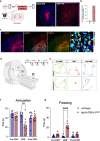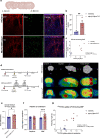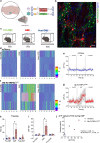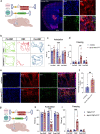This is a preprint.
Bidirectional Regulation of Motor Circuits Using Magnetogenetic Gene Therapy Short: Magnetogenetic Regulation of Motor Circuits
- PMID: 37503198
- PMCID: PMC10369996
- DOI: 10.1101/2023.07.13.548699
Bidirectional Regulation of Motor Circuits Using Magnetogenetic Gene Therapy Short: Magnetogenetic Regulation of Motor Circuits
Update in
-
Bidirectional regulation of motor circuits using magnetogenetic gene therapy.Sci Adv. 2024 Oct 11;10(41):eadp9150. doi: 10.1126/sciadv.adp9150. Epub 2024 Oct 9. Sci Adv. 2024. PMID: 39383230 Free PMC article.
Abstract
Here we report a novel suite of magnetogenetic tools, based on a single anti-ferritin nanobody-TRPV1 receptor fusion protein, which regulated neuronal activity when exposed to magnetic fields. AAV-mediated delivery of a floxed nanobody-TRPV1 into the striatum of adenosine 2a receptor-cre driver mice resulted in motor freezing when placed in an MRI or adjacent to a transcranial magnetic stimulation (TMS) device. Functional imaging and fiber photometry both confirmed activation of the target region in response to the magnetic fields. Expression of the same construct in the striatum of wild-type mice along with a second injection of an AAVretro expressing cre into the globus pallidus led to similar circuit specificity and motor responses. Finally, a mutation was generated to gate chloride and inhibit neuronal activity. Expression of this variant in subthalamic nucleus in PitX2-cre parkinsonian mice resulted in reduced local c-fos expression and motor rotational behavior. These data demonstrate that magnetogenetic constructs can bidirectionally regulate activity of specific neuronal circuits non-invasively in-vivo using clinically available devices.
Conflict of interest statement
Competing interest The authors declare no competing interests.
Figures








References
-
- Benabid A. L., Chabardes S., Mitrofanis J., Pollak P., Deep brain stimulation of the subthalamic nucleus for the treatment of Parkinson’s disease. Lancet Neurol 8, 67–81 (2009). - PubMed
-
- Boyden E. S., Zhang F., Bamberg E., Nagel G., Deisseroth K., Millisecond-timescale, genetically targeted optical control of neural activity. Nat Neurosci 8, 1263–1268 (2005). - PubMed
Publication types
Grants and funding
LinkOut - more resources
Full Text Sources
